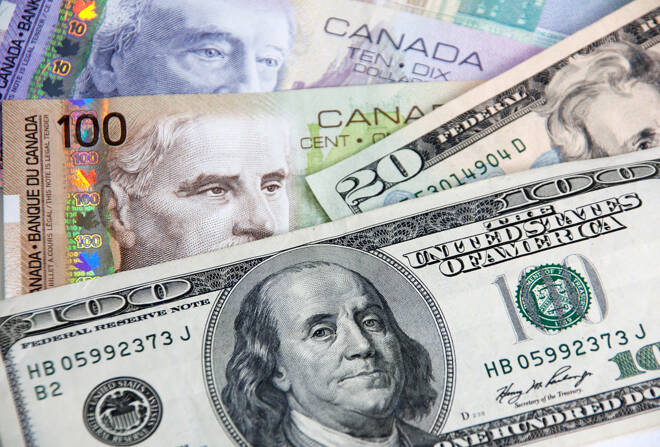Advertisement
Advertisement
USD/CAD: Loonie Remains Weak on Hopes of Hawkish U.S. Fed Views
By:
There has been a lot of attention paid to central bank risk this week, and Wednesday's Fed policy decision is at the centre of it all.
The Canadian dollar weakened against its U.S. counterpart on Wednesday as investors remain cautious ahead of the Federal Reserve’s policy announcement on Wednesday, where it is widely expected to signal an earlier end to its asset purchases; weak crude oil prices also weighed on the commodity currency.
“The CAD is finding it hard to resist the broader push higher in the USD this morning even with the risk backdrop of stocks and commodities not especially negative. All indications are that the Bank’s 2% inflation target will be retained but the mandate will contain language which allows for policymakers to allow for changes in the labour market when setting policy,” noted Shaun Osborne, Chief FX Strategist at Scotiabank in its Dec 13 note.
“We note that Canadian short-term yields have edged lower in the past couple of sessions, compressing spreads somewhat and weighing on the CAD, as markets await details of the Bank’s new mandate—although we doubt the new framework will materially alter near-term rate prospects.”
Today, the USD/CAD pair rose to 1.2834 up from Monday’s close of 1.2804. The Canadian dollar hit its lowest level in over two months last week. After gaining about 2.3% in October, the loonie weakened over 3.1% last month.
“Against its peers (AUD and NZD), also likely to weigh on CAD is Canada’s deteriorating terms of trade in 2022 on a bearish outlook for oil vs a more positive outlook for industrial metals (AUD) and dairy (NZD). Citi forecasts $50-60/bbl Brent in 6-12mths,” noted analysts at Citi.
Investors looked forward to the Federal Reserve’s key meeting later this week. At the time of writing, the dollar index, which measures the value of the dollar against six foreign currencies, was trading 0.11% lower at 96.213.
On Wednesday, the Fed will likely announce an acceleration of its bond-buying program. Fed’s decision may also be influenced by consumer price inflation data, which hit nearly 40 years high in November.
“The concern at the Fed will be that high inflation today can fuel expectations of higher inflation tomorrow and the day after that and so on. This can then feed through into wage demands and in an environment of decent corporate pricing power we see those costs post onto customers,” noted James Knightley, Chief International Economist at ING.
“The Fed will be keen to avoid this (or be seen willing to tolerate it), hence our expectations for a faster taper…with the programme concluding in February. We also expect them to signal the prospect of two rate hikes in their “dot plot”, up from the one they currently have.”
The Invesco DB US Dollar Index Bullish Fund, which is designed for investors who want a cost-effective and convenient way to track the value of the U.S. dollar relative to a basket of the six major world currencies – the euro, Japanese yen, British pound, Canadian dollar, Swedish krona and Swiss franc – closed 0.31% higher at 25.83 on Monday.
“This week presents one of the final opportunities of the year for some significant moves in FX markets, as a whole host of developed and emerging market central banks hold meetings. So far, it has been a good year for the US dollar, the Canadian dollar and the Chinese renminbi. Expect these trends to largely continue – especially the strong US dollar,” noted Francesco Pesole, FX Strategist at ING.
The last minutes of the U.S. Federal Reserve meeting confirmed market expectations that the Fed will raise rates sooner than other major central banks. The greenback hovers near the 16-month high against most other major currencies because of the hottest U.S. inflation reading in a generation that pushed investors to bet that interest rates are likely to rise sooner than previously thought.
It is highly likely that the world’s dominant reserve currency, the USD, will rise by the first quarter of next year, largely due to the expectation of at least one rate hike in 2022. With the dollar strengthening and a possibility that the Federal Reserve will raise interest rates earlier than expected, the USD/CAD pair may experience a rise.
Canada is the world’s fourth-largest exporter of oil, which edged lower as new coronavirus Omicron variant risks weigh. At the time of writing, U.S. West Texas Intermediate (WTI) crude was trading 1.22% lower at $70.43 a barrel. Lower oil prices lead to lower U.S. dollar earnings for Canadian exporters, resulting in a decreased value of the loonie.
About the Author
Vivek Kumarauthor
Vivek has over five years of experience in working for the financial market as a strategist and economist.
Advertisement
